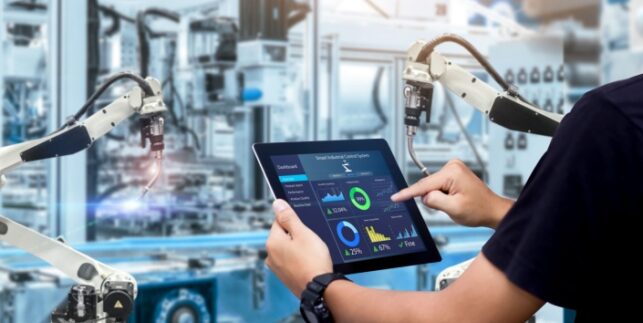What Are the 3 Phases of Shop Floor Control

Mastering the shop floor control process is a key concern for plants and other production facilities. Shop floor control operates in three distinct phases: order release, order scheduling, and order progress.
Real-Time Operational Intelligence (RtOI) capabilities allow organizations to track and optimize ongoing production inside their factories. Each phase is impacted by the availability of real-time data, transforming from a slow and static process into a dynamic, flexible, and optimized operation.
Phase 1: Order Release – Resource Planning in Real-Time
The benefits of real-time operational intelligence software in phase 1 relate largely to shop floor planning and resource management.
This includes:
- Job cards to allocate the appropriate amount of labor time to each order
- Materials requisitions for the specific types and amounts of materials needed
- Move tickets to indicate when materials, parts, or other items must be moved to different production areas within your facility during the same production round
- Route sheets to establish the process plan that your team will follow to complete the order
Managers and planners use Real-time Operational Intelligence (RtOI) solutions to review which resources are currently available within the factory at any given time, including materials, machinery, and labor. Each time a new order is released into the queue, this information is automatically updated to give stakeholders a more relevant picture of what is happening on the floor at that moment. They can then use this information to respond proactively to the plant’s projected resource needs. For instance, if materials use is particularly high, planners might decide to order an additional batch of those materials to compensate for the rise in demand.
Phase 2: Order Scheduling – Aligning Production and Up-to-the-Minute Demand
Real-Time Operational Intelligence (RtOI) solutions can transform phase 2 of the manufacturing process with their ability to track orders in real-time and rearrange production to suit present conditions. Plants can use this technology to shift to dynamic production models, taking on new orders as soon as they come in rather than waiting to slot them into the next day’s schedule. If an order is suddenly canceled, the software will immediately remove it from the schedule and replace it with a new order from the facility’s queue.
Improving production agility in this way not only maximizes the plant’s output but also allows you to capitalize on fleeting demand opportunities. For instance, many paper goods factories experienced higher-than-normal demand for toilet paper products during the initial days of the COVID-19 pandemic. The plants that were able to produce the most toilet paper before the stockpiling craze ended enjoyed significantly higher revenue during that period. This influx of demand would have been difficult to manage using manual methods but could be easily tracked and accommodated with RtOI software.
Phase 3: Order Progress – Solving Problems Proactively in Real-Time
As the longest of the three phases, the order progress phase benefits the most from real-time shop floor tracking capabilities.
Production shop floor management is never as straightforward in real life as it is on paper. From materials management and machine breakdowns to sick calls and on-the-job injuries, there are countless variables that impact the output, speed, and overall efficiency of a working factory.
Real-time data tracking provides instant, continuous, and omnipresent visibility into your factory’s operations, no matter what is happening on the floor.
With this information available at the touch of a button, management can surveil the state of the entire floor from any location and initiate timely interventions when needed to keep production running smoothly. Many RtOI solutions even offer built-in chat tools and management controls that can be used for this purpose.
Advanced shop floor control software can also assist with proactive production floor management. Using historical data from the RtOI software, managers can establish gold standard parameters for your factory’s unique environment. Your shop floor control software can then be programmed to issue alerts when certain parameters fall below expected levels.
Data fluctuations indicate there are likely problems in those areas, even if they are still too new to have a measurable impact on production. If your team remains ready to respond as soon as an alert is raised, you can stay one step ahead of most common production problems.
Over time, you see results:
- Labor is used more efficiently.
- Machine availability is maximized.
- Machine breakdowns occur less frequently.
- Materials waste is minimized.
- Production cycle times are kept consistently low.
All of these improvements eventually lead to a much higher OEE (overall equipment effectiveness score) (arguably the most important of all factory KPIs [key performance indicators]).

Changing the way people work in factories
Request a DemoTaking Advantage of Automation in Shop Floor Control
There is no doubt that improved visibility and transparency are considerable resources that can greatly improve operations on the shop floor. Monitoring and alerts increase these benefits, but there is another step that manufacturers can take to extend their control even further.
Matics RtOI also features work management tools that allow manufacturers to take the foundation provided by data aggregation and analysis and build on it with action. Real-time alerts provide a considerable reduction in latency and improved productivity, but automated work management tools can do even more.
With these tools, manufacturers are able to decide which actions must be taken when an event happens on the shop floor and have them executed automatically. Task management and communication all happen within the RtOI system, providing a wide range of options to build responses through rule allocations.
When a certain KPI goes over a threshold, or a machine shuts down unexpectedly, Matics RtOI can respond with more than a simple alert to the production team. Instead, workflows can be put into motion immediately to provide the fastest and most effective solution.
Supercharge All Shop Floor Control Phases With Matics
Real-time operational intelligence (RtOI) is an indispensable tool in all three phases of modern shop floor control. With it, manufacturers can easily implement Industry 4.0 best practices and reap the associated rewards, including higher productivity, less waste, and greater profitability.
Are you searching for shop floor control software that offers true real-time operational intelligence? Matics gives you and your team constant access to contextually relevant data about current events on your factory floor. Our software is a multifaceted manufacturing intelligence solution that:
- Adds an additional source of information with instant chat capabilities, including the ability to send messages to individuals, groups, or the entire factory at once
- Can be retrofitted into any factory setup with just a few hours of basic installation
- Issues programmed alerts to aid managers in reacting swiftly to crisis situations on the floor
- Provides ongoing trend analysis using machine learning and AI
- Pulls data from the full range of sources in your factory, including your CMS, machine sensors, and any existing ERP or MES solutions
- Provides an accessible platform that can be customized to suit the needs of specific roles
- Gives manufacturers full control over the metrics used to monitor, track, and analyze their processes
- Puts entire workflows into action in response to events with sophisticated work management tools
We also offer fully functioning demos of our software so you can make an informed purchase decision. Contact us today to request one of these demos or to learn more about how your factory could benefit from implementing our real-time software solution.




